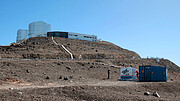Annuncio
Looking for tsunami clues in the skies above Paranal with OASIS
30 Aprile 2024
As part of a collaboration between the German Aerospace Center (DLR) and ESO, the Observations of Airglow with Spectrometer and Imager Systems (OASIS) project has officially joined the ranks of ESO’s Paranal Observatory. Best known for hosting world-leading astronomical observatories, like ESO’s Very Large Telescope, Paranal also happens to be ideally suited for certain atmospheric observations. Operated by DLR and hosted by ESO, OASIS aims to show that monitoring “airglow” in our atmosphere has potential to provide early warnings for tsunamis.
Tsunamis, giant waves caused mostly by earthquakes under the sea, are a destructive force of nature that can result in a significant loss of life and damage to infrastructure. OASIS aims to show that it is possible to mitigate some of the impacts of these natural hazards by monitoring our atmosphere. Earthquakes generate sound waves that travel upwards through the atmosphere. These perturbations affect the so-called airglow or nightglow — the natural emission of molecules high up in the atmosphere. OASIS will monitor this airglow, specifically the emission from hydroxyl molecules at a height of around 86 km, which could eventually be used to issue tsunami early warnings.
Paranal is uniquely suited to observing the atmosphere due to its special environmental and climate conditions. Chile’s Atacama Desert, where Paranal is located, boasts a uniquely dry climate ideal for both astronomical and atmospheric observations. Chile is also close to two tectonic plate boundaries that often produce strong earthquakes, including some that generate tsunamis.
As a side effect of monitoring airglow on a given night, OASIS also has the potential to benefit its neighbouring telescopes. Airglow appears as a dim glow that prevents the night sky from being entirely dark, which can affect observations from ground-based telescopes. While methods exist to account for it, airglow is a complex and constantly changing phenomenon. The regular airglow monitoring data OASIS will collect could be used to help forecast the airglow brightness on a given night, with potential to eventually help ESO better account for airglow in astronomical observations and optimise the use of telescope time.
The inauguration of OASIS took place late last week, more than a year after the first test observations were obtained by OASIS instruments. As part of the inauguration event, DLR and ESO staff came together at Paranal for general presentations on the project followed by a roundtable discussion on cooperation opportunities.
Links
Contatti
Alain Smette
ESO Staff Astronomer
Paranal, Chile
Tel: +56 2 2463 3113
Email: asmette@eso.org
Patrick Hannawald
DLR German Remote Sensing Data Center, Atmosphere
Weßling, Germany
Tel.: +49 8153 28-3566
Email: Patrick.Hannawald@dlr.de
Bárbara Ferreira
ESO Media Manager
Garching bei München, Germany
Tel: +49 89 3200 6670
Email: press@eso.org
Riguardo all'annuncio
| Identificazione: | ann24006 |




